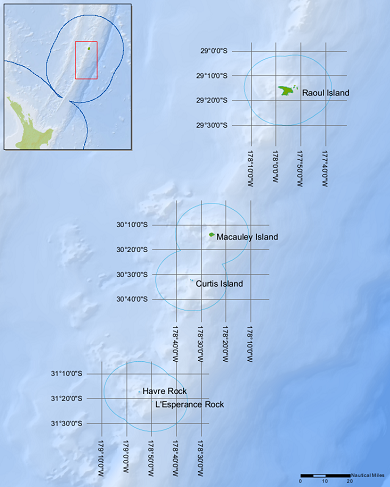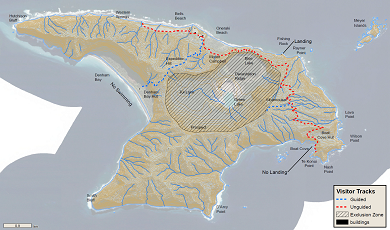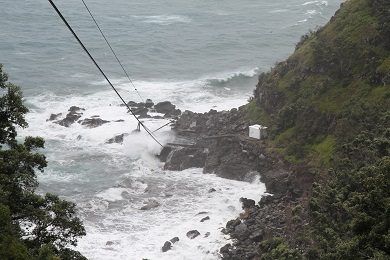The Kermadec Islands Nature Reserve and Marine Reserve is the most remote area managed by DOC. Biosecurity conditions are in place to minimise the risk of ecological damage through the inadvertent introduction of potential pest species such as rodents, invertebrates, weeds, fungi and disease.
Marine access

Kermadec Islands Marine Reserve | View Larger (2,589 K)
Most people pass near Raoul island on their way to Pacific islands further north. The journey takes most boats 4-5 days. The waters around all the islands and rocks, out to the edge of the Territorial Sea (12 nautical miles) are considered part of the Kermadec Islands Marine Reserve.
This means fishing of any kind in these areas is an offence, as is the taking or disturbing of any marine life including shellfish and seaweeds. It is also an offence to take any part of the seafloor, which includes any shells and rocks on the beach.
Access conditions
Special permission must be granted by Customs New Zealand to enter the waters or stop at the Kermadecs when travelling from overseas to or from New Zealand. The requirement is that you travel directly from one customs clearance port to another customs clearance port.
Once this exemption has been granted, you will need to supply evidence of this to DOC. Your vessel must also meet the requirements of DOCs regional coastal plan for this area. The plan states that you will need to provide evidence of the last antifoul and maintenance on the vessel's hull, and evidence that the hull is clean. If you cannot provide this evidence, you will need to stay 1000m off any island in the Kermadecs group.
There are also specific rules regarding anchorages you must use at Raoul island:
- general access is restricted to 300m close to shore at Raoul island and 600m for all other islands
- there are exception areas for anchorages at Raoul, Meyer and Chanter islands. These include Denham Bay, Meyer Islets, Boat Cove and Fishing Rock
- vessels <75m long can go into the zone 600m from shore at the northeast of Macauley Island to launch and collect zodiacs and passengers for zodiac cruising.
Overview of vessel requirements
- Heavy fuel oil is prohibited in the coastal marine area of the islands, as fuel or cargo.
- If a vessel will access within 1000m from shore (specifically, mean high water springs (MHWS) to 1000m), the vessel must have a current anti-fouling system (within the in-service period) and have completed a hull inspection (frequency depends on how old the vessels anti-fouling is).
- Hull inspections must have been carried out by approved persons.
Hull Fouling Inspections
Vessels intending to go inside 1000m from mean high water springs of the islands must have had an approved independent inspector certify that your vessel has a clean hull. Yachting NZ Category 1 inspectors are approved to complete this for yachts. You can find a list of these inspectors on the Yachting NZ website.
Vessel owners must complete the DOC hull inspection record form and include details of their most recent anti-fouling maintenance.
Further guidance on hull inspections including a list of approved inspectors and inspection forms can be found alongside the Regional Coastal Plan for the Kermadec Islands.

Raoul Island visitor access map | View larger (PDF 1,528K)
Land access
The Kermadec Islands are nature reserves protected under the 1977 Reserves Act. The Act requires all visitors landing on the island to obtain and comply with an entry permit. Entry permits are only issued for Raoul island, and stipulate what places visitors can access and when.
Raoul Island is an active volcanic site. Due to the number of known hazards heightened by the remote location, areas that can be visited on the island are restricted.
Access conditions
Permits are subject to a number of conditions and facilitate landings to Fishing Rock only.
To obtain an entry permit there are a number of biosecurity requirements you must fulfil before leaving mainland New Zealand, during your visit and on departure. The permit does not allow for research, commercial filming, drone flying or commercial guiding. Separate permits for these activities are required.
Permits are not issued for landing during re-supply, maintenance and repairs periods. These occur twice a year, usually during March and September.

Fishing Rock landing site | View larger (JPEG, 503K)
Overview of permit requirements
- Applications must allow a minimum of 30 working days for processing. Complex applications may take longer.
- Due to difficult landing conditions, visitors to the island must be fit, agile and at least 12 years of age.
- Permits are limited to two one day visits per trip with no overnight stay allowed.
- You must fulfil all biosecurity requirements before and during your visit.
- If you intend to travel onwards to another country, you must provide evidence of an exemption from Customs New Zealand.
Biosecurity requirements
To meet our biosecurity requirements, you must
- complete the biosecurity checklist (Word, 369K)
- agree to the minimum impact code (PDF, 22K)
- complete the myrtle rust decontamination procedure (PDF, 154K)
- allow DOC to complete a rodent check on your vessel (using Conservation dogs).
Application form
Before you apply, it is recommended you contact the Raoul Island team for a pre-application discussion as there is a non-refundable application fee for all entry permits.
The application form provides an estimate of associated costs including biosecurity inspection, quarantine, pre-departure vessel check for rodents (by conservation dogs), pre-departure hull inspection and landing fee:
Tour operators
Private companies who wish to take tourists to the islands must hold a ‘concession’ to undertake a commercial activity on New Zealand public conservation land.
As well as their concession, they must also obtain the required entry permit, which permits access to the Raoul Island Nature Reserve. Transport to and from the Kermadec Islands must be independently arranged and the above conditions for land and marine access apply.
Researchers
Before you apply for land access permit, a separate activity permit must be obtained before doing so.
Transport to and from the Kermadec Islands must be independently arranged and the above conditions for both land and marine access apply.
